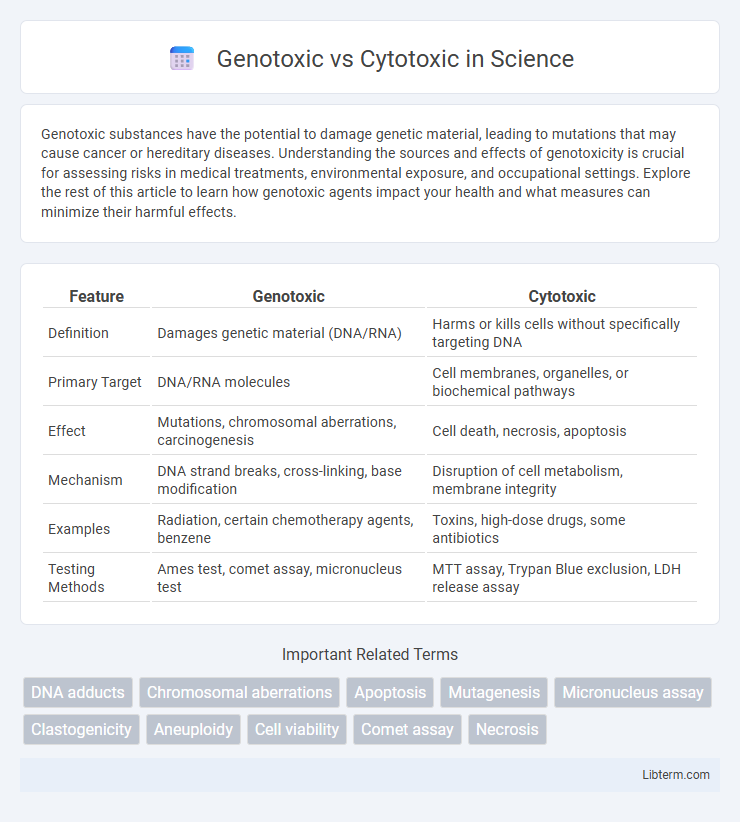Genotoxic substances have the potential to damage genetic material, leading to mutations that may cause cancer or hereditary diseases. Understanding the sources and effects of genotoxicity is crucial for assessing risks in medical treatments, environmental exposure, and occupational settings. Explore the rest of this article to learn how genotoxic agents impact your health and what measures can minimize their harmful effects.
Table of Comparison
| Feature | Genotoxic | Cytotoxic |
|---|---|---|
| Definition | Damages genetic material (DNA/RNA) | Harms or kills cells without specifically targeting DNA |
| Primary Target | DNA/RNA molecules | Cell membranes, organelles, or biochemical pathways |
| Effect | Mutations, chromosomal aberrations, carcinogenesis | Cell death, necrosis, apoptosis |
| Mechanism | DNA strand breaks, cross-linking, base modification | Disruption of cell metabolism, membrane integrity |
| Examples | Radiation, certain chemotherapy agents, benzene | Toxins, high-dose drugs, some antibiotics |
| Testing Methods | Ames test, comet assay, micronucleus test | MTT assay, Trypan Blue exclusion, LDH release assay |
Introduction to Genotoxicity and Cytotoxicity
Genotoxicity refers to the ability of harmful agents to damage genetic material, leading to mutations, chromosomal fragmentation, or DNA strand breaks, which can contribute to carcinogenesis or hereditary defects. Cytotoxicity involves the toxic effects of substances on cells, causing cell damage or cell death through mechanisms such as membrane disruption, enzyme inhibition, or mitochondrial dysfunction. Both genotoxic and cytotoxic assessments are crucial in evaluating chemical safety and potential health risks associated with environmental toxins, pharmaceuticals, and industrial compounds.
Defining Genotoxicity: Mechanisms and Effects
Genotoxicity refers to the ability of harmful agents to damage genetic material, causing mutations, chromosomal fragmentation, or DNA strand breaks that can lead to cancer and hereditary defects. Mechanisms of genotoxicity include direct DNA interaction, generation of reactive oxygen species (ROS), and interference with DNA replication and repair processes. Unlike cytotoxicity, which primarily causes cell death or impaired cell function, genotoxicity specifically targets genetic integrity, posing long-term risks to cellular and organismal health.
Understanding Cytotoxicity: Mechanisms and Outcomes
Cytotoxicity refers to the ability of certain substances or agents to cause damage and death to cells through mechanisms such as membrane disruption, oxidative stress, and interference with cellular metabolism. Unlike genotoxicity, which specifically damages genetic material leading to mutations, cytotoxicity can result in apoptosis, necrosis, or other forms of cell death without directly altering DNA. Understanding cytotoxicity is critical in drug development and toxicology for evaluating cell viability, therapeutic efficacy, and potential side effects.
Key Differences Between Genotoxic and Cytotoxic Effects
Genotoxic effects involve damage to the genetic material within a cell, leading to mutations, DNA strand breaks, or chromosomal aberrations that can result in carcinogenesis or heritable genetic changes. Cytotoxic effects refer to the ability of substances to cause cell damage or cell death without directly altering DNA, primarily affecting cell viability and function through mechanisms like membrane disruption or enzyme inactivation. The key difference lies in genotoxicity targeting the genome with potential long-term genetic consequences, while cytotoxicity primarily compromises cell survival and metabolic activity without necessarily inducing genetic mutations.
Common Agents Causing Genotoxicity
Common agents causing genotoxicity include chemical mutagens such as alkylating agents, polycyclic aromatic hydrocarbons, and certain pesticides known to induce DNA damage or mutations. Physical agents like ionizing radiation and ultraviolet light also contribute significantly to genotoxic effects by causing DNA strand breaks and thymine dimers. These genotoxic agents disrupt genomic integrity, leading to mutations that may result in carcinogenesis or heritable genetic defects.
Common Agents Causing Cytotoxicity
Common agents causing cytotoxicity include chemotherapeutic drugs such as doxorubicin, cisplatin, and paclitaxel, which disrupt cellular processes leading to cell death. Environmental toxins like heavy metals (mercury, cadmium) and pesticides also contribute to cytotoxic effects by damaging cellular membranes and interfering with enzyme function. Radiation exposure and reactive oxygen species (ROS) further induce cytotoxicity by causing oxidative stress and direct cellular damage.
Laboratory Tests for Genotoxicity Assessment
Genotoxicity assessment primarily involves laboratory tests such as the Ames test, micronucleus assay, and comet assay, which detect DNA damage, mutations, and chromosomal alterations. These tests evaluate whether a substance causes genetic mutations or chromosomal aberrations indicative of genotoxic effects, distinct from cytotoxicity that targets general cell viability. The distinction is critical as genotoxicity tests focus on DNA integrity, while cytotoxicity assays measure overall cell health and death.
Laboratory Methods for Cytotoxicity Evaluation
Laboratory methods for cytotoxicity evaluation primarily involve assays such as MTT, LDH release, and trypan blue exclusion, which measure cell viability, membrane integrity, and metabolic activity. These techniques differentiate cytotoxic effects, where agents induce cell death or dysfunction, from genotoxic effects that specifically damage DNA without immediate cell death. Accurate cytotoxicity assessment supports drug development and safety testing by identifying compounds causing cellular damage distinct from genetic mutations.
Health Implications of Genotoxic vs Cytotoxic Agents
Genotoxic agents cause damage to the genetic material, leading to mutations and increasing the risk of cancer and hereditary defects, whereas cytotoxic agents primarily induce cell death without directly altering DNA. Exposure to genotoxic substances necessitates stringent monitoring due to their potential long-term carcinogenic and mutagenic effects on human health. Cytotoxic compounds, while toxic to cells, are often used therapeutically in chemotherapy to target rapidly dividing cancer cells but require careful dosage control to minimize adverse impacts on healthy tissue.
Regulatory Guidelines and Safety Considerations
Regulatory guidelines distinguish genotoxicity from cytotoxicity based on their effects: genotoxicity refers to DNA damage with potential heritable mutations, while cytotoxicity involves cell damage or death without direct genetic alterations. Safety considerations require genotoxicity testing to assess carcinogenic and mutagenic risks, as outlined by agencies like the FDA, EMA, and ICH (e.g., ICH S2(R1) guidelines), whereas cytotoxicity evaluation helps determine safe exposure levels and potential tissue toxicity. Compliance with these regulatory frameworks ensures that pharmaceuticals and chemicals undergo thorough risk assessment to protect human health and the environment.
Genotoxic Infographic

 libterm.com
libterm.com